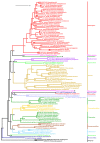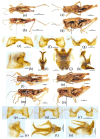The Complete Mitogenomes of Three Grasshopper Species with Special Notes on the Phylogenetic Positions of Some Related Genera
- PMID: 36662013
- PMCID: PMC9865218
- DOI: 10.3390/insects14010085
The Complete Mitogenomes of Three Grasshopper Species with Special Notes on the Phylogenetic Positions of Some Related Genera
Abstract
Clarifying phylogenetic position and reconstructing robust phylogeny of groups using various evidences are an eternal theme for taxonomy and systematics. In this study, the complete mitogenomes of Longzhouacris mirabilis, Ranacris albicornis, and Conophyma zhaosuensis were sequenced using next-generation sequencing (NGS), and the characteristics of the mitogenomes are presented briefly. The mitogenomes of the three species are all circular molecules with total lengths of 16,164 bp, 15,720 bp, and 16,190 bp, respectively. The gene structures and orders, as well as the characteristics of the mitogenomes, are similar to those of other published mitogenomes in Caelifera. The phylogeny of the main subfamilies of Acrididae with prosternal process was reconstructed using a selected dataset of mitogenome sequences under maximum likelihood (ML) and Bayesian inference (BI) frameworks. The results showed that the genus Emeiacris consistently fell into the subfamily Melanoplinae rather than Oxyinae, and the genus Choroedocus had the closest relationship with Shirackiacris of the subfamily Eyprepocnemidinae in both phylogenetic trees deduced from mitogenome protein coding genes (PCGs). This finding is entirely consistent with the morphological characters, which indicate that Emeiacris belongs to Melanoplinae and Choroedocus belongs to Eyprepocnemidinae. In addition, the genera Conophymacris and Xiangelilacris, as well as Ranacris and Menglacris, are two pairs of the closest relatives, but their phylogenetic positions need further study to clarify.
Keywords: Acrididae; Conophyma; Longzhouacris; Ranacris; mitogenome; phylogenetic position.
Conflict of interest statement
The authors declare no conflict of interest.
Figures









Similar articles
-
Phylogenetic Position of the Genus Alulacris (Orthoptera: Acrididae: Melanoplinae: Podismini) Revealed by Complete Mitogenome Evidence.Insects. 2021 Oct 8;12(10):918. doi: 10.3390/insects12100918. Insects. 2021. PMID: 34680687 Free PMC article.
-
The complete mitochondrial genome of the grasshopper Chorthippus dubius (Zub.) (Orthoptera: Acrididae: Gomphocerinae): detailed characterization and phylogenetic position.Mitochondrial DNA A DNA Mapp Seq Anal. 2025 Apr-May;35(3-4):111-118. doi: 10.1080/24701394.2024.2446772. Epub 2024 Dec 30. Mitochondrial DNA A DNA Mapp Seq Anal. 2025. PMID: 40264337
-
Characterization of Four Complete Mitogenomes of Monolepta Species and Their Related Phylogenetic Implications.Insects. 2024 Jan 11;15(1):50. doi: 10.3390/insects15010050. Insects. 2024. PMID: 38249056 Free PMC article.
-
Evolutionary progression of mitochondrial gene rearrangements and phylogenetic relationships in Strigidae (Strigiformes).Gene. 2018 Oct 20;674:8-14. doi: 10.1016/j.gene.2018.06.066. Epub 2018 Jun 22. Gene. 2018. PMID: 29940272
-
Comparative mitogenome analysis of three species and monophyletic inference of Catantopinae (Orthoptera: Acridoidea).Genomics. 2019 Dec;111(6):1728-1735. doi: 10.1016/j.ygeno.2018.11.027. Epub 2018 Nov 29. Genomics. 2019. PMID: 30503746
Cited by
-
Phylogenetics and Evolutionary Dynamics of Yunnan Acrididae Grasshoppers Inferred from 17 New Mitochondrial Genomes.Insects. 2025 Feb 3;16(2):151. doi: 10.3390/insects16020151. Insects. 2025. PMID: 40003781 Free PMC article.
-
The complete mitochondrial genome of Phymateus saxosus (Coquerel, 1861) (Orthoptera: Pyrgomorphidae) and phylogenetic analysis.Mitochondrial DNA B Resour. 2024 Apr 4;9(4):457-460. doi: 10.1080/23802359.2024.2316064. eCollection 2024. Mitochondrial DNA B Resour. 2024. PMID: 38591051 Free PMC article.
-
The Mitogenomic Characterization and Phylogenetic Analysis of the Plant Pathogen Phyllosticta yuccae.Genes (Basel). 2024 Jan 17;15(1):111. doi: 10.3390/genes15010111. Genes (Basel). 2024. PMID: 38255000 Free PMC article.
-
Comparative analysis of mitogenomes among three species of grasshoppers (Orthoptera: Acridoidea: Gomphocerinae) and their phylogenetic implications.PeerJ. 2023 Dec 15;11:e16550. doi: 10.7717/peerj.16550. eCollection 2023. PeerJ. 2023. PMID: 38111661 Free PMC article.
-
Complete mitochondrial genomes and phylogenetic relationships of two Saussurella species (Orthoptera: Tetrigidae) from China.Mitochondrial DNA B Resour. 2025 May 13;10(6):447-452. doi: 10.1080/23802359.2025.2503408. eCollection 2025. Mitochondrial DNA B Resour. 2025. PMID: 40371125 Free PMC article.
References
-
- Lecoq M., Zhang L. Encyclopedia of Pest Orthoptera of the World. China Agricultural University Press; Beijing, China: 2019.
-
- Mugleston J., Naegle M., Song H., Bybee S.M., Ingley S., Suvorov A., Whiting M.F. Reinventing the leaf: Multiple origins of leaf-like wings in katydids (Orthoptera: Tettigoniidae) Invertebr. Syst. 2016;30:335–352. doi: 10.1071/IS15055. - DOI
-
- Chen L.P., Zheng F.Y., Bai J., Wang J.M., Lv C.Y., Li X., Zhi Y.C., Li X.J. Comparative analysis of mitogenomes among six species of grasshoppers (Orthoptera: Acridoidea: Catantopidae) and their phylogenetic implications in wing-type evolution. Int. J. Biol. Macromol. 2020;159:1062–1072. doi: 10.1016/j.ijbiomac.2020.05.058. - DOI - PubMed
-
- Song H., Béthoux O., Shin S., Donath A., Letsch H., Liu S., McKenna D.D., Meng G., Misof B., Podsiadlowski L., et al. Phylogenomic analysis sheds light on the evolutionary pathways towards acoustic communication in Orthoptera. Nat. Commun. 2020;11:4939. doi: 10.1038/s41467-020-18739-4. - DOI - PMC - PubMed
Grants and funding
LinkOut - more resources
Full Text Sources

